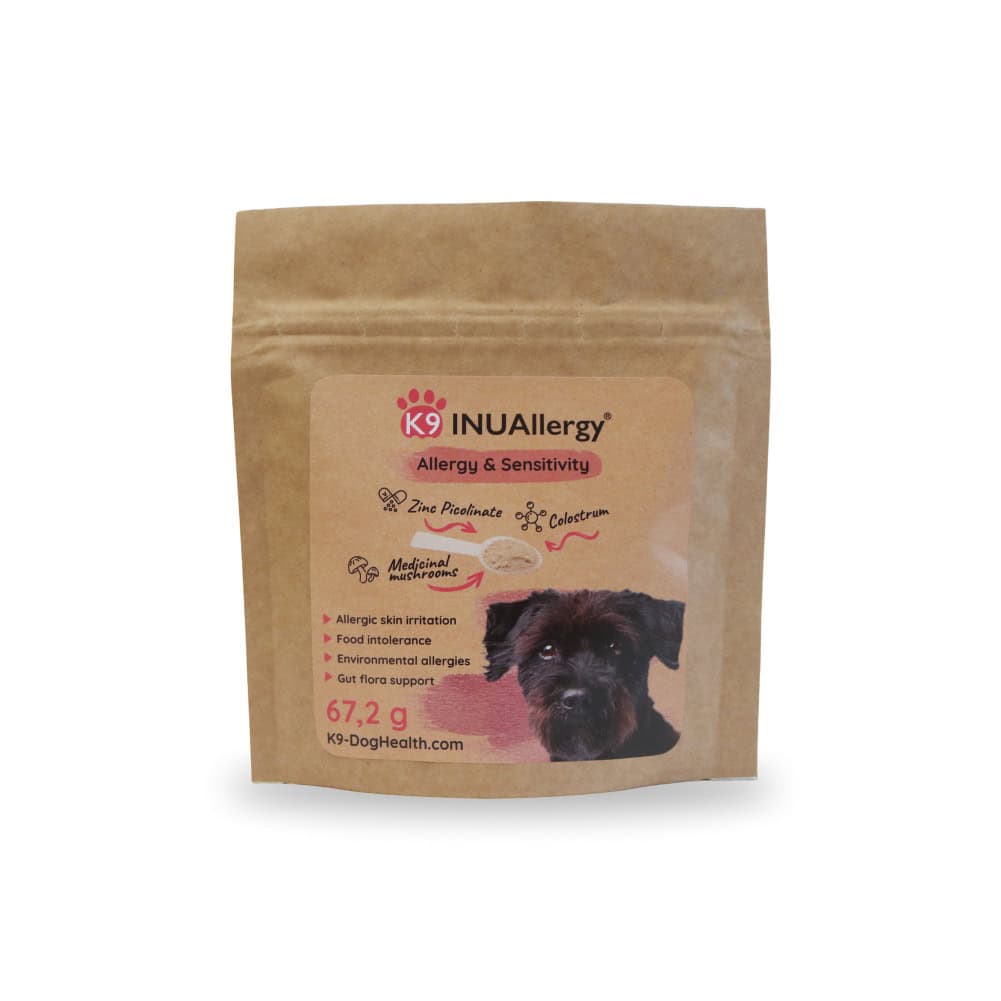Dog food allergy – How to recognize it and what you can do
If your dog is constantly scratching, has digestive issues, or behaves strangely after meals, it may be struggling with a dog food allergy. This condition is becoming more common and is often hard to detect, as it can cause a wide range of symptoms. In this article, we’ll explain how to identify it, what the most common triggers are, which treatment options are available, and what natural solutions might help in the long run.
What is a food allergy, and how is it different from food intolerance?
A dog food allergy is an overreaction of the immune system to certain foods – usually proteins. This means the body identifies a harmless ingredient as a threat and triggers an immune response. This reaction often causes inflammation, skin problems, or digestive issues. Food allergy in dogs is often mistaken for food intolerance, which is a digestive disorder but not immune-related – for example, the inability to break down lactose.
Most common symptoms of dog food allergy
Allergic reactions can affect multiple organ systems. The most frequent symptom is itchiness, especially on the paws, face, ears, and belly. Diarrhea, vomiting, bloating, as well as chronic ear infections and skin inflammation may also occur. Dog chicken allergy symptoms often appear in this form, as chicken is one of the most common allergens.
Diagnosis – how to confirm a dog food allergy
The most reliable diagnostic method is the so-called elimination diet. This involves feeding your dog for at least 8 weeks with food that contains no known allergens. This may be hydrolyzed protein-based food – where proteins are broken down into smaller parts so the immune system no longer recognizes them – or novel protein sources that are rarely used (e.g. duck, rabbit, kangaroo).
Blood and skin tests are currently of limited reliability, as not all allergic reactions are detectable with these methods. Microbiome analysis is gaining more attention. It examines the composition of the gut flora, which in dogs can directly influence immune hypersensitivity. Another emerging tool is epigenetic testing, which looks at how gene expression is affected by environmental factors – helping us understand why some dogs become sensitive to certain proteins.

What is microbiome analysis and how can it help with dog food allergy?
The microorganisms – bacteria, fungi, viruses – living in a dog’s gut make up the microbiome. This ecosystem plays a key role in immune function, nutrient absorption, and allergy regulation. Analyzing the microbiome can help detect dysbiosis – an imbalance between good and bad bacteria – which is often linked to food allergies and digestive disorders.
When is microbiome testing worth considering?
- Recurring or hard-to-treat food allergy symptoms
- Chronic diarrhea, bloating, or constipation
- Weakened immunity after antibiotic treatment
- Persistent skin problems, itching, or ear infections
Where can you get a dog microbiome test?
More and more veterinary clinics are working with international labs, but home-order microbiome tests are also safe and informative. Among the most well-known are the Embark and Petivity tests. These provide detailed gut flora analysis and interpretation guides.
What can the results tell you?

Important note
Microbiome testing does not replace veterinary diagnosis but can be a helpful tool in complex allergy assessments. It’s especially useful when traditional allergy tests don’t provide clear answers or when multiple symptoms are present at once.
Epigenetic testing in dogs
Epigenetics studies how environmental factors – such as stress, diet, or toxins – affect gene expression without altering the DNA sequence itself. This science helps us understand why some dogs develop allergic reactions even if they had no previous sensitivity to a specific protein. Epigenetic changes can amplify immune responses, leading to chronic inflammation, skin issues, or food intolerance.
Advanced veterinary tests are now available that measure a dog’s biological age based on epigenetic patterns – especially DNA methylation profiles. This biological age may differ from chronological age and can indicate hidden inflammation, oxidative stress, or lifestyle-related burdens. Examples include the Embark Dog Age Test and the EpiPaws Pet Age Test, which help assess the dog’s overall epigenetic health.
While few clinics in Hungary currently offer epigenetic testing, international services are now available online. EpiPaws has developed a test specifically for pets, using saliva samples to provide a detailed report on the dog’s biological condition. Embark offers a similar solution, and with its research background, is one of the best-known genetic service providers. These results can help identify which environmental or lifestyle factors affect your dog’s immune system – and how to reduce their impact.
It’s important to note that epigenetic tests do not react to specific allergens. Instead, they provide insight into the body’s general condition and environmental sensitivity. As a supplementary tool, they can help guide the diagnostic process – especially when classic allergy tests are inconclusive.
How to treat a dog food allergy
The most important step is removing the allergen completely from the diet. After that, focus on restoring digestion, reducing inflammation, and supporting the immune system long-term. Natural ingredients like omega-3 fatty acids (EPA and DHA), probiotics, colostrum, and certain medicinal mushrooms are helpful for restoring gut and immune balance.
In chronic or severe cases, the vet may recommend medication such as antihistamines or corticosteroids. These may offer quick relief but can have long-term side effects, so they are usually used for symptom control. There are also immune-modulating drugs, but they suppress the entire immune system. In contrast, natural immune modulators – such as medicinal mushrooms – help restore immune balance without side effects. A new experimental approach is oral immunotherapy, where the allergen is gradually reintroduced in microdoses to teach the immune system tolerance – but this is not yet a standard method in dogs.
Common myths about food allergies
Prevention tips
Pay attention to your dog’s bowls – plastic bowls often cause contact allergies. Use stainless steel or ceramic. Keep an allergy food diary to record what your dog eats and any symptoms that occur. This can help identify patterns and speed up diagnosis later.
Prognosis – what to expect in the long term
Summary
Managing dog food allergy takes time, but with dietary changes, natural support, and veterinary guidance, it is controllable. In addition to an elimination diet, pay attention to gut health, reduce stress, and avoid environmental allergens. If you already recognize the dog chicken allergy symptoms, don’t delay evaluation – prolonged symptoms may lead to secondary infections and chronic inflammation. Click here to read more about kutya ételallergia in Hungarian.
Recommended reading
If your dog struggles with sensitive skin or frequent scratching, read our article on Dog skin allergies – it offers useful tips for managing itchiness, dandruff, and inflammation. Proper fatty acid intake also matters: Fish oil for dogs is rich in omega-3 fatty acids (K9 INUKrill®) that help with skin and digestive symptoms.
Sometimes scratching is caused not only by food sensitivities but also by parasites. Our summary on dog fleas can help you navigate this issue. For mental and physical stimulation, explore how Frisbee can benefit your dog’s overall health.
Functional ingredients are key in natural allergy support. In our Natural ingredients section, you’ll find compounds like medicinal mushrooms, colostrum, and krill oil that may help maintain immune balance. For deeper insights into the link between immunity and chronic illness, visit our Dog tumor articles.
Important: This article is for informational purposes only and is not a substitute for veterinary examination or treatment. Always consult your veterinarian for an accurate diagnosis and appropriate therapy.
References:
- Olivry, T., & Mueller, R. S. (2014): Common food allergens in dogs and cats. BMC Veterinary Research, 10:9.
- Bunyavanich, S., & Berin, M. C. (2020): Food Allergy and the Microbiome. Journal of Allergy and Clinical Immunology, 145(1), 23–28.
- Peterson, A. L. et al. (2019): Evaluation of elimination diet trials in dogs with suspected food-induced allergic dermatitis. Veterinary Dermatology, 30(6), 460–e137.
- Clear, R. et al. (2023): Comparison of the Gut Microbiome between Atopic and Healthy Dogs. Animals (MDPI), 12(18):2377.
- The Merck Veterinary Manual (2020): Cutaneous Food Allergy in Animals.
- Sheikh, A. A. et al. (2017): Food allergy in canines: A review. Journal of Entomology and Zoology Studies, 5(6), Part U.



